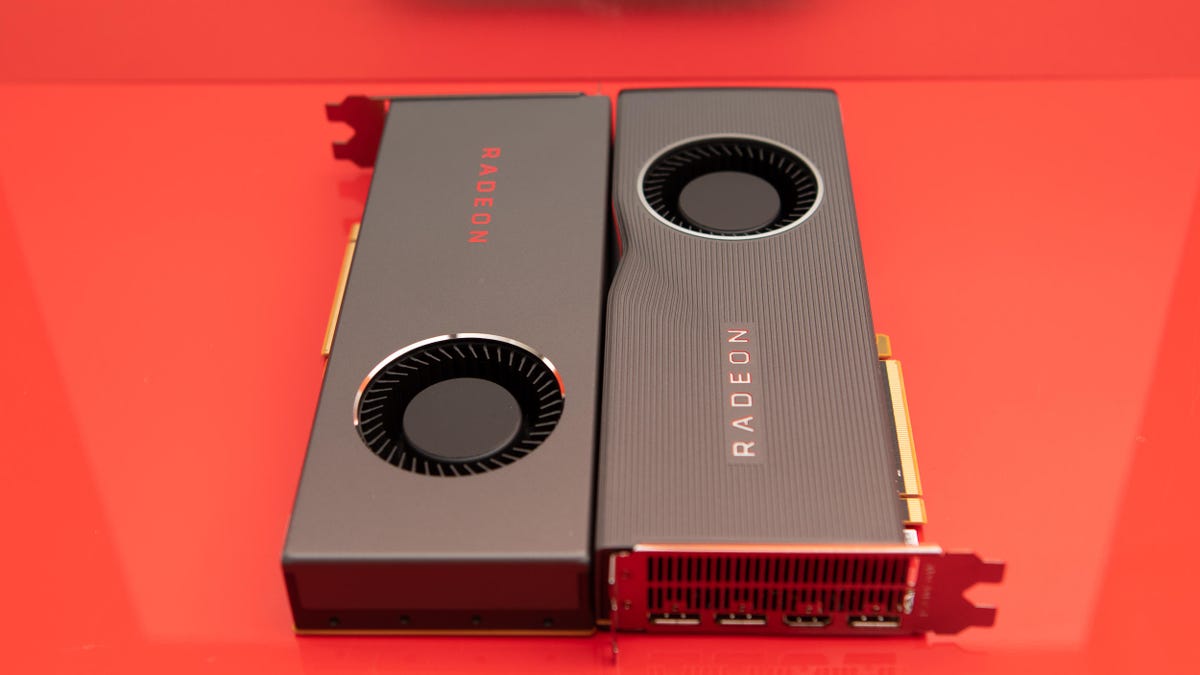AMD Radeon RX 5700 series battles for 1440p gaming
The new midrange RX 5700 and RX 5700 XT cards make a good first impression.

The battle rages on. A week before AMD was scheduled to deliver the details about its new Navi-generation midrange graphics cards, the Radeon RX 5700 and RX 5700 XT, rival Nvidia announced bumped-up "Super" versions of its directly competing RTX 2060 and RTX 2070 at slightly lower prices than AMD had publicly revealed for its new cards. So two days prior to its rollout, AMD dropped the prices on its cards to match: $349 for the 5700, $399 for the XT version and $449 for the 50th anniversary edition version of the 5700 XT.
While 1080p gaming remains the most popular resolution, 1440p (2,560 x 1,440) is the next enthusiast frontier, and both companies want a piece of it -- so much so that they've entered into a price war before their cards have even shipped. The 5700 series is available now.
Comparative specifications
| GPU | Nvidia GeForce RTX 2060 | AMD Radeon RX 5700 | Nvidia GeForce RTX 2060 Super | AMD Radeon RX 5700 XT | Nvidia GeForce RTX 2070 Super |
|---|---|---|---|---|---|
| Memory (GDDR6) | 6GB | 8GB | 8GB | 8GB | 8GB |
| Memory bandwidth (GB/sec) | 336 | 448 | 448 | 448 | 448 |
| GPU clock speed (MHz, base/boost) | 1,365/1,680 | 1,465/1,725 | 1,470/1,560 | 1,605/1,905 | 1,605/1,770 |
| Memory data rate/Interface | 14Gbps/192 bit | 14Gbps/256 bit | 14Gbps/256 bit | 14Gbps/256 bit | 14Gbps/256 bit |
| CUDA cores/ compute units | 1,920 | 2,304 | 2,176 | 2,560 | 2,560 |
| Stream processors | 30 | 36 | 34 | 40 | 40 |
| FP32 (teraflops) | 6.5 | 8.0 | 7.2 | 9.8 | 9.1 |
| TGP | 160w | 180w | 175w | 225w | 215w |
| Price | $349 | $349 | $399 | $399 | $499 |
But AMD's entering the battle with a revamped processor architecture, hoping to break the perception of being the "value" option rather than the performance leader. And based on our preliminary testing, the RX 5700 does seem to deliver better frame rates across various benchmarks than the RTX 2060, at least at 1080p. Unfortunately, we don't have an RTX 2060 Super yet for comparison.
While the Radeon VII remains the flagship card in AMD's gaming line, its technology straddles generations -- it's built on AMD's 7nm process, but it doesn't have the upgraded memory architecture, PCIe 4 support, more efficient compute-unit design, lower power draw, quiet operation and more that comprises AMD's "RDNA" architecture for the Navi generation. With Navi, AMD moves from using HBM2 (high-bandwidth memory) to the more widely used GDDR6 for its consumer products.
AMD positions both cards as 1440p contenders, but the extra $50 buys you the ability to play at a higher-quality setting. Across the board, we saw roughly a 10% increase in frame rates from the 5700 to the 5700 XT at 1440p, and both delivered average frame rates of more than 70fps overall.
You get 3 DisplayPort and 1 HDMI connection.
And the cards are very quiet. They are bigger and do require more power than the RTX 2060 -- it uses similar connections to the 2080 Ti, and they're both bigger than the 2060 -- but the 2060 Super has increased power requirements as well. In addition to differences in the number of compute units (the rasterization engine of a graphics processor) and clock speeds, the 5700 and 5700 XT differ by look. The 5700 XT has a less featureless surface and the logo glows red, plus only part of the internal circuit board peeps out; the 5700's entire underside is exposed.
They do have the same connectors on the back, however, 3 DisplayPort 1.4 and 1 HDMI 2.0b. I do miss having a USB-C port back there like on an Nvidia card since they're still pretty rare in desktop systems.
Along with the cards, AMD revved its Adrenalin utility software with a few new features, most notably Radeon Image Sharpening (RIS) and Anti-lag. RIS does what Nvidia's DLSS is intended to (without the AI), provide a better image when playing at higher resolutions -- e.g., displaying in 1440p while the graphics card is only working with 1080p, to minimize the performance hit of a higher resolution. (My testing was interrupted by a network outage in our lab, so I was unable to download some games I wanted for visual comparison.)
Specifically, RIS uses a technique called contrast-adaptive sharpening to improve detail on textures with less-defined edges. (CAS is similar to what the new Texture tool in Lightroom does.) There are two flavors: game developers can integrate support or you can toggle it in Adrenalin to apply it on the fly for unsupported games. The former will deliver better results. As far as I could tell, there was no performance penalty for applying it in the driver.
Anti-lag essentially works to better sync the CPU and GPU so there are fewer wasted cycles between the time you click the mouse and the display responds -- AMD claims about 30% improvement.
Editor's note: updated 1:48 p.m. ET. with correct availability date.

